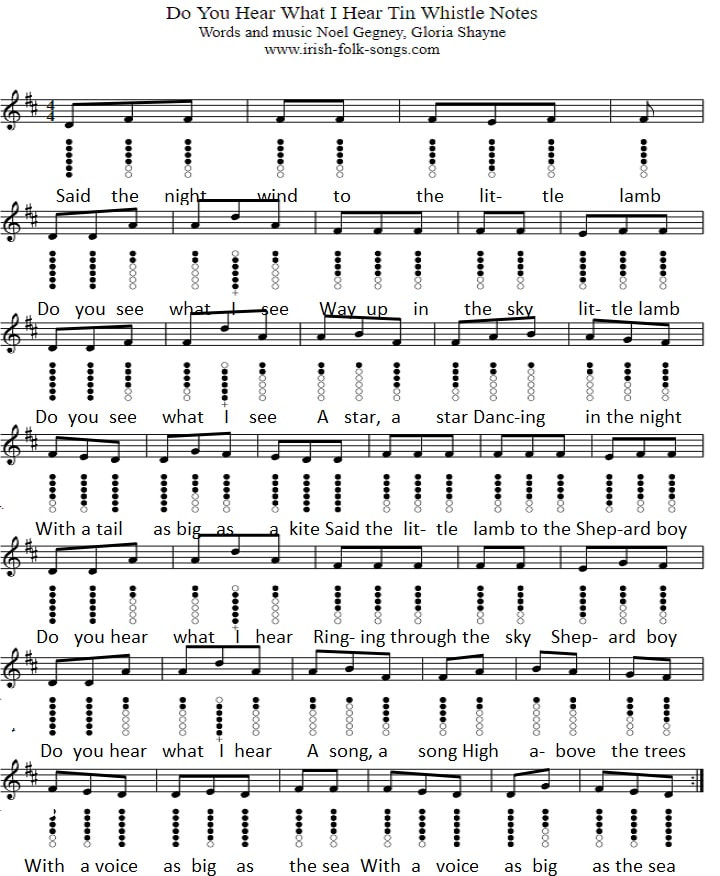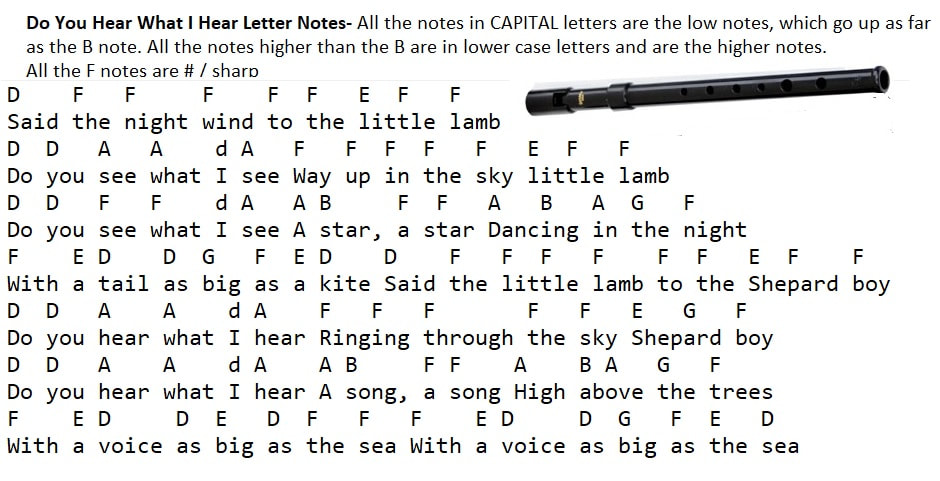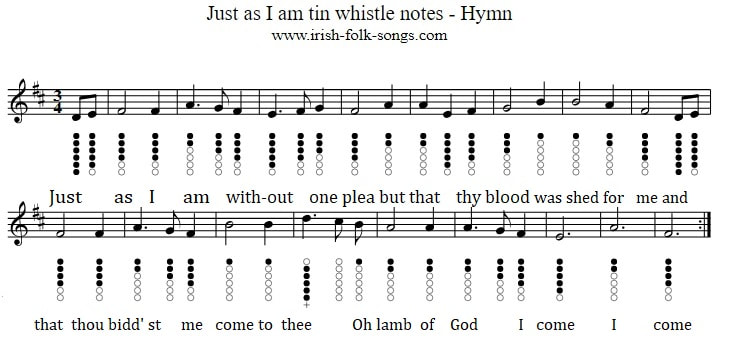Do You Hear What I Hear Tin Whistle Sheet Music Notes
Do You Hear What I Hear sheet music is in the key of D Major. The easy to play letter notes are also included. This Christmas song on tin whistle was recorded by Bing Crosby, Carrie Underwood and Orla Fallen to name a few. The letter notation is suitable for the recorder and flute. Another popular hymn Just As I Am is also included here.
The song 'Do You Hear What I Hear' is a beloved Christmas carol that has stood the test of time and continues to be a staple in holiday music. Written in 1962 by husband and wife duo, Noel Regney and Gloria Shayne, the song has evolved from a simple poem to a powerful message of hope and peace. Over the years, it has been recorded by countless artists, adapted into different languages, and used in various forms of media. The enduring popularity of this song begs the question, what makes 'Do You Hear What I Hear' so special and why does it continue to resonate with people around the world?
To begin with, the song's origin story is a remarkable one. It all started during the height of the Cold War, a time of great tension and fear between the United States and the Soviet Union. Noel Regney, a French composer who had served in the French army during World War II, was deeply troubled by the state of the world and the possibility of another devastating war. In the midst of this turmoil, he was asked by a record company to write a Christmas song. This request came at a time when Regney was struggling with his own inner turmoil, feeling conflicted about the commercialization of Christmas and the true meaning of the holiday. He turned to his wife, Gloria Shayne, also a composer, for help. Together, they crafted a song that would send a powerful message of peace and hope during a time of great uncertainty.
The lyrics of 'Do You Hear What I Hear' are simple yet profound. It tells the story of the Nativity, beginning with a little lamb who sees a star and asks the shepherd boy if he hears what he hears. The question is then passed on to the king, who hears the wind singing of a promise of peace, and to the people everywhere, who are called upon to pray for peace. The song ends with the message that the child, the son of God, is the one who brings peace to all. The use of questions and imagery in the lyrics creates a sense of wonder and invites listeners to reflect on the true message of Christmas. The song's message of peace and hope is universal and transcends religious boundaries, making it relatable to people of all backgrounds.
The musical composition of 'Do You Hear What I Hear' is also a testament to its enduring popularity. The melody is catchy and easy to sing along to, making it a perfect Christmas carol for all ages. The song's structure is also unique, with each verse building upon the previous one, leading up to the powerful climax at the end. The use of different vocal ranges also adds depth and emotion to the song, from the soft and gentle beginning to the powerful and triumphant ending. Additionally, the song's simple chord progression and use of traditional instruments, such as the guitar and piano, make it easy to adapt and perform in different styles, from traditional church choirs to modern pop renditions.
The success of 'Do You Hear What I Hear' can also be attributed to the numerous covers and adaptations that have been made over the years. The song has been recorded by a wide range of artists, from Bing Crosby to Whitney Houston, ensuring its place in popular culture. It has also been translated into multiple languages, including Spanish, French, and German, making it accessible to a global audience. The song has also been featured in movies, TV shows, and commercials, further solidifying its place in popular culture and ensuring its continued relevance.
In conclusion, 'Do You Hear What I Hear' is more than just a Christmas carol. It is a powerful message of peace and hope, born out of a time of great turmoil and uncertainty. Its simple yet profound lyrics and catchy melody have made it a beloved holiday song that continues to resonate with people around the world. Its enduring popularity can be attributed to its universal message, memorable composition, and adaptability. As long as there are people who need a reminder of the true meaning of Christmas, 'Do You Hear What I Hear' will continue to be heard and cherished.
To begin with, the song's origin story is a remarkable one. It all started during the height of the Cold War, a time of great tension and fear between the United States and the Soviet Union. Noel Regney, a French composer who had served in the French army during World War II, was deeply troubled by the state of the world and the possibility of another devastating war. In the midst of this turmoil, he was asked by a record company to write a Christmas song. This request came at a time when Regney was struggling with his own inner turmoil, feeling conflicted about the commercialization of Christmas and the true meaning of the holiday. He turned to his wife, Gloria Shayne, also a composer, for help. Together, they crafted a song that would send a powerful message of peace and hope during a time of great uncertainty.
The lyrics of 'Do You Hear What I Hear' are simple yet profound. It tells the story of the Nativity, beginning with a little lamb who sees a star and asks the shepherd boy if he hears what he hears. The question is then passed on to the king, who hears the wind singing of a promise of peace, and to the people everywhere, who are called upon to pray for peace. The song ends with the message that the child, the son of God, is the one who brings peace to all. The use of questions and imagery in the lyrics creates a sense of wonder and invites listeners to reflect on the true message of Christmas. The song's message of peace and hope is universal and transcends religious boundaries, making it relatable to people of all backgrounds.
The musical composition of 'Do You Hear What I Hear' is also a testament to its enduring popularity. The melody is catchy and easy to sing along to, making it a perfect Christmas carol for all ages. The song's structure is also unique, with each verse building upon the previous one, leading up to the powerful climax at the end. The use of different vocal ranges also adds depth and emotion to the song, from the soft and gentle beginning to the powerful and triumphant ending. Additionally, the song's simple chord progression and use of traditional instruments, such as the guitar and piano, make it easy to adapt and perform in different styles, from traditional church choirs to modern pop renditions.
The success of 'Do You Hear What I Hear' can also be attributed to the numerous covers and adaptations that have been made over the years. The song has been recorded by a wide range of artists, from Bing Crosby to Whitney Houston, ensuring its place in popular culture. It has also been translated into multiple languages, including Spanish, French, and German, making it accessible to a global audience. The song has also been featured in movies, TV shows, and commercials, further solidifying its place in popular culture and ensuring its continued relevance.
In conclusion, 'Do You Hear What I Hear' is more than just a Christmas carol. It is a powerful message of peace and hope, born out of a time of great turmoil and uncertainty. Its simple yet profound lyrics and catchy melody have made it a beloved holiday song that continues to resonate with people around the world. Its enduring popularity can be attributed to its universal message, memorable composition, and adaptability. As long as there are people who need a reminder of the true meaning of Christmas, 'Do You Hear What I Hear' will continue to be heard and cherished.
The video is by Fiddling With My Tin Whistle.
Below is the popular Christian hymn Just As I Am.



